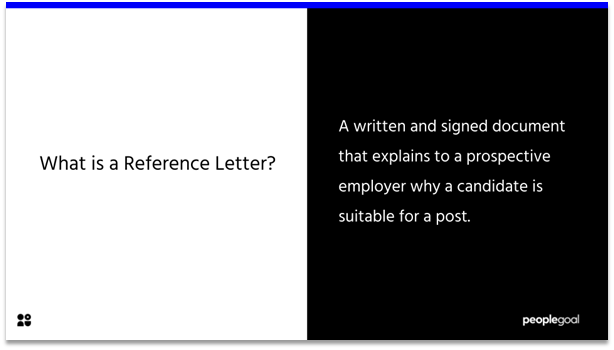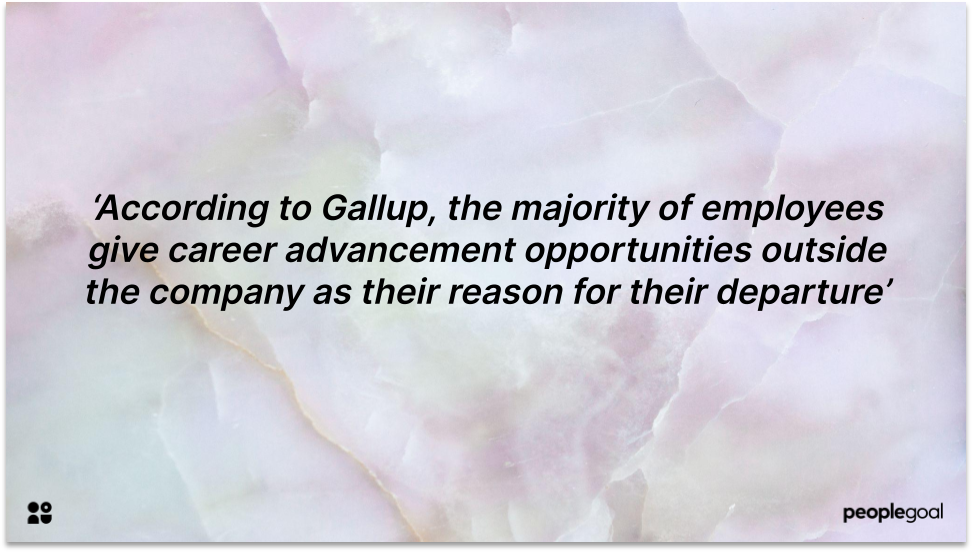You’ve likely found that PerformYard is a solid choice for performance management, but what if there’s a tool that aligns even better with your evolving needs? As organizations grow and their HR strategies become more dynamic, the quest for the right platform often leads to exploring new options. The ones that offer enhanced flexibility, deeper insights, and more seamless integrations.
In this guide, I’ll introduce you to 10 top PerformYard alternatives that are gaining traction in 2025. Each of these tools brings something unique to the table. Whether it’s more customizable workflows, stronger employee engagement features, or the ability to scale as your team expands.
By the end of this blog, you’ll have a better sense of which option could be the perfect fit for your organization’s next phase.
Why Companies Look for PerformYard Alternatives
Every team’s HR journey evolves — and sometimes that means exploring other options to find a better fit. Here’s what usually drives the search for PerformYard alternatives:
- Growing teams need more flexibility
As organizations expand, they look for platforms that can handle different review cycles, departments, and workflows without extra manual effort. - Desire for deeper insights
HR leaders want analytics that go beyond surface metrics — visual dashboards, engagement trends, and data that can drive smarter decisions. - All-in-one convenience
Many companies prefer tools that combine performance, engagement, payroll, and learning in one place, instead of juggling multiple systems. - Scalability and value
As teams grow, cost and scalability become important. Businesses often explore tools that offer more features or automation within a similar budget. - User-friendly experience
Teams today expect modern, intuitive interfaces that make feedback and reviews easy for everyone — not just HR.
Exploring alternatives isn’t about what PerformYard lacks — it’s about finding the right match for your people, goals, and growth stage.
List of 10 Best PerformYard Alternatives
If you’re looking for a better fit than PerformYard, here’s a list of the top alternatives that can help you enhance performance management, employee engagement, employee development, and HR processes.
| Tool | Best For | Pricing |
|---|---|---|
| PeopleGoal | Boosting Employee Performance & Improving Engagement | FREE 7-day trial. Paid starts at $4/user/month. |
| Lattice | Performance Management | Starts at $10/user/month |
| 15Five | Weekly Check-Ins and Feedback Culture | Starts at $4/user/month |
| Leapsome | Personalized Learning Paths | Custom pricing |
| Rippling | All-in-One HR, IT & Payroll Automation | Custom pricing |
| Gusto | Simple Payroll & HR | Starts at $49/month |
| Zenefits | Administration & Compliance Support for SMBs | Starts at $8/user/month |
| HiBob | Modern HRIS With Customizable Global Workflows | Starts at $5/user/month |
| ADP Workforce Now | Enterprise-Grade HR & Payroll Suite | Custom pricing |
| Paylocity | HR Platform With Built-in Engagement | Custom pricing |
1. PeopleGoal – Best for Boosting Employee Performance & Improving Engagement
I used PeopleGoal to transform a rigid annual review process at a creative agency, and it was truly helpful. We had been struggling with infrequent feedback and one-size-fits-all HR workflows.
After switching to PeopleGoal, within weeks, we were running automated 30-day new-hire check-ins and even launching department-specific 360° feedback reviews.
I had built DEI-aligned performance goals, linked engagement survey results to development plans. I also created a custom onboarding app using the App Store inside the platform. Every feature was configurable to our needs. In short, PeopleGoal gave me total control to design our own HR processes, rather than being stuck with rigid templates.
Pros:
- Highly flexible and customizable. You can build your own workflows, forms, and even custom HR apps for things like onboarding or feedback.
- Employee performance management, engagement, development & HR features in one place. Supports goals/OKRs, continuous feedback, 360° reviews, and pulse surveys all integrated.
- Easy to set up automated check-ins, reminders, and condition-based workflows (no more manual HR task tracking).
- Integrates into tools like Slack/Microsoft Teams for real-time feedback and recognition, keeping HR processes in the daily flow.
How PeopleGoal Compares to PerformYard:
PerformYard offers solid tools for structured reviews and goal tracking, but PeopleGoal gives you more flexibility to build a system that truly fits your team. You can customize review workflows, OKRs, and feedback processes. Plus add engagement elements like peer recognition and pulse surveys in one place. While PerformYard focuses mainly on performance reviews, PeopleGoal goes further by combining performance management with continuous feedback and employee engagement features that help teams stay motivated and aligned.
Pricing:
FREE 7-day trial. Paid starts at $4/user/month.
2. Lattice – Best for Performance Management
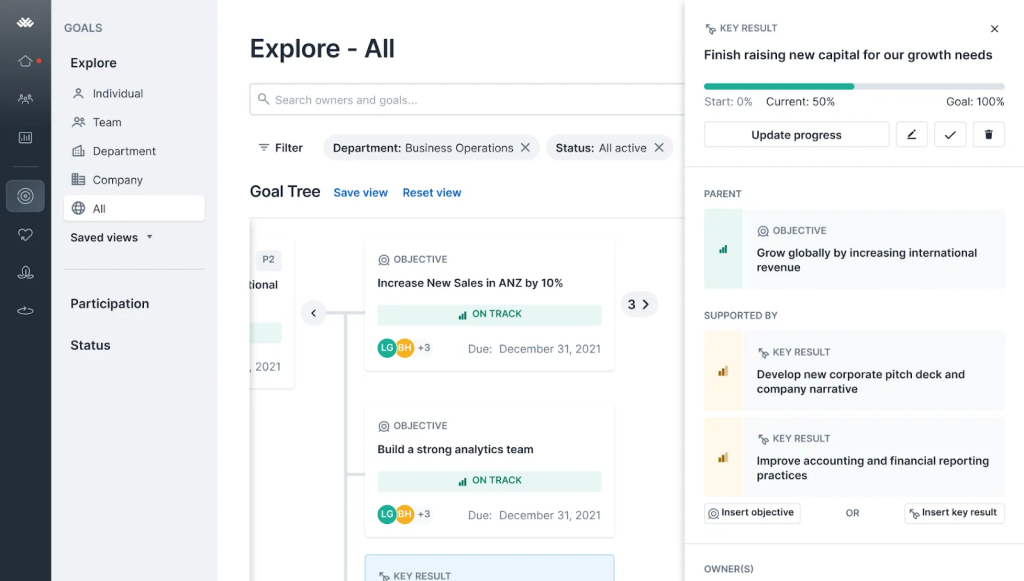
Image source: Lattice
At a high-growth startup I advised, our old HR tools couldn’t keep up with managing performance. We deployed Lattice, and suddenly every manager was holding structured 1:1 meetings. In fact, every employee had clear OKRs aligned to company goals, and HR could monitor performance trends in real time.
I had used Lattice myself and found it clean, fast, and powerful. One engineering manager told me it was the first time she could connect feedback, career growth, and compensation in one place. Features like manager toolkits, engagement surveys, growth plans, and pulse feedback were all interconnected. And we didn’t need five different tools anymore to cover those areas.
Lattice essentially replaced static yearly reviews with dynamic conversations and ongoing development, which we saw boost morale and retention on the team.
Pros:
- Supports flexible review cadences (quarterly, monthly, or ongoing) instead of just annual cycles.
- OKR and goal alignment let individuals align with team and organization objectives, promoting transparency on progress.
- Includes features like growth plans, competency matrices, and development tracks to support employee career paths.
- Offers pulse surveys with sentiment analysis and dashboards, giving actionable engagement data to HR.
How Lattice Compares to PerformYard:
PerformYard focuses on structured performance reviews and goal tracking, while Lattice adds a stronger layer of engagement and real-time feedback. Lattice offers tools like one-on-one meeting templates, continuous feedback, and employee engagement surveys that help managers stay connected with their teams throughout the year. However, PerformYard provides more control over review cycles and goal-setting workflows. This makes it ideal for organizations that prioritize structured performance evaluations over frequent feedback loops.
Pricing:
Starts at $10/user/month.
3. 15Five – Best for Weekly Check-Ins and Feedback Culture
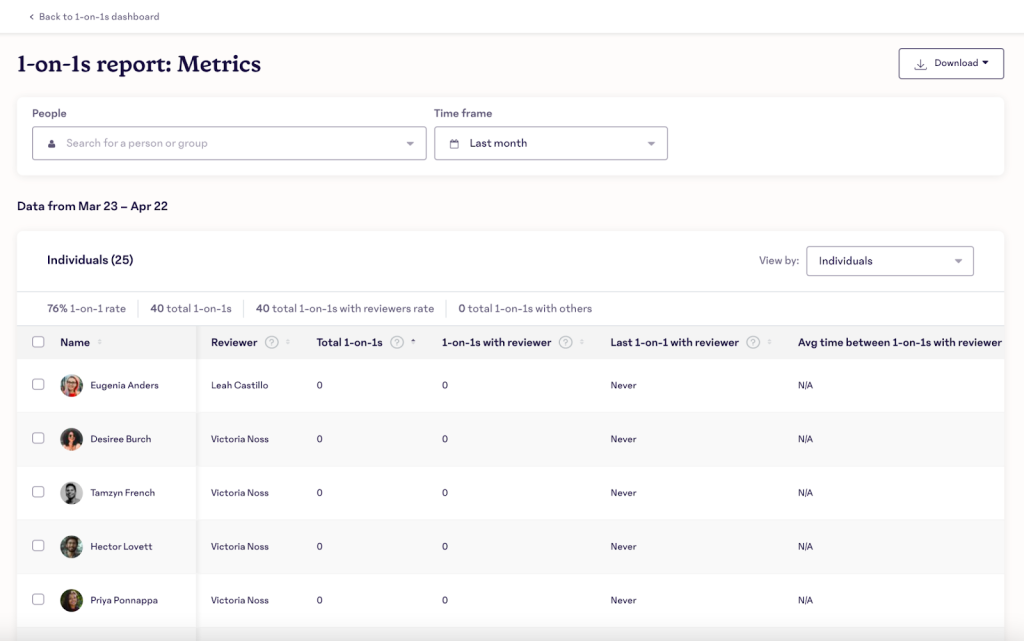
Image source: 15Five
I introduced 15Five at a media agency where managers only gave feedback during yearly reviews. After we rolled out 15Five, it completely flipped our communication rhythm. Managers began using the weekly check-in feature, and by the third week, they were proactively identifying and solving problems in their teams.
Personally, I loved using 15Five because it felt more like a habit tracker for good management than a traditional HR system. Each week, employees would outline their priorities, flag blockers, and share wins, and managers would respond in real time. This consistent dialogue made sure nothing festered until year end.
One feature I found especially impactful was the Best-Self Review. It blended performance evaluation with personal development discussions, so reviews felt supportive rather than punitive. With 15Five, our managers truly became coaches. No one was surprised at performance review time because feedback was happening continuously.
Pros:
- Weekly check-ins and status updates that establish a regular feedback loop between employees and managers.
- Goals and OKRs can be updated and tracked on an ongoing basis (not just yearly).
- Includes 360° feedback and peer recognition (through the “High Five” feature) which helps build a positive, supportive team culture.
- Provides tools for 1-on-1 meetings – prompts and templates that help managers have meaningful coaching conversations with their reports.
How 15Five Compares to PerformYard:
15Five excels at promoting continuous feedback and engagement through weekly check-ins, pulse surveys, and one-on-one tools. This makes it great for maintaining an open feedback culture. PerformYard, on the other hand, focuses more on structured performance management with detailed review workflows, goal alignment, and reporting. While 15Five emphasizes ongoing communication and employee well-being, PerformYard provides deeper customization and formal review capabilities suited for organizations that need a more traditional, metrics-driven performance process.
Pricing:
Starts at $4/user/month.
4. Leapsome – Best for Personalized Learning Paths
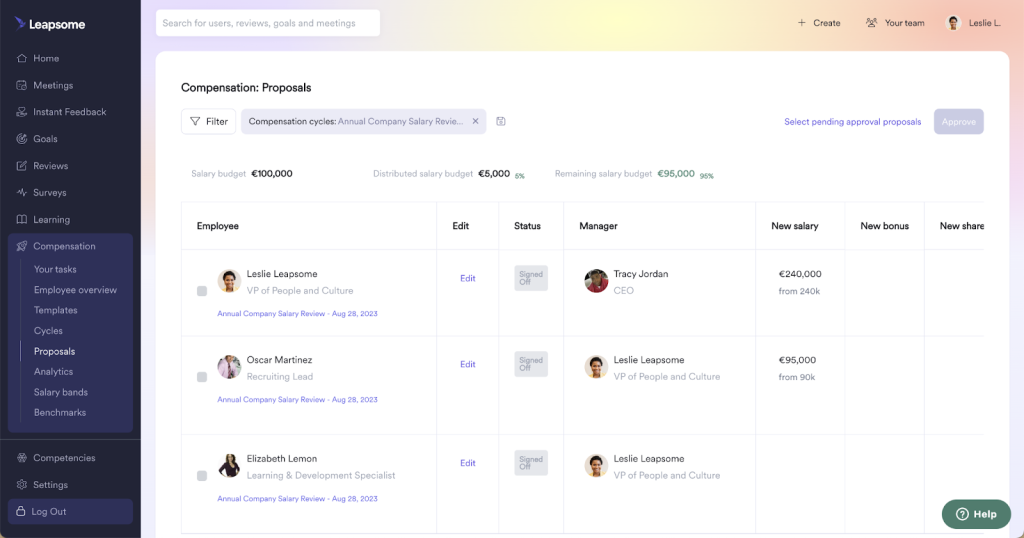
Image source: Leapsome
One mid-sized tech company I consulted for was juggling four different platforms – one for performance reviews, one for employee surveys, one for goals/OKRs, and another for learning content. We decided to roll all those needs into Leapsome, and it was like switching from manual to autopilot. With Leapsome, after a performance review concluded, we could automatically assign a relevant learning course to that employee.
If we sent out a pulse engagement survey, we could seamlessly tie the feedback into actionable OKRs for managers. I saw teams use Leapsome’s AI-driven sentiment analysis to catch cultural issues in survey comments before they escalated.
Leapsome is one of the rare platforms like PeopleGoal that handles performance management and employee development equally well. For any company trying to scale without buying a dozen different HR tools, Leapsome provided a one-dashboard solution that kept everything connected.
Pros:
- Combines performance reviews, goals/OKR tracking, engagement surveys, and even a built-in Learning Management System (LMS).
- You can link performance outcomes to learning content (e.g. assign training based on review feedback) to foster continuous development.
- Offers flexible pulse surveys with heatmaps, trend analysis, and AI sentiment analysis to gauge employee engagement and morale.
- OKR and goal management features at individual, team, and company levels, with real-time progress visuals (keeping everyone aligned).
How Leapsome Compares to PerformYard:
Leapsome combines performance management, learning, and engagement in one platform, offering a more holistic approach to employee development. It supports OKRs, feedback, and personalized learning paths, making it ideal for companies that want to connect performance reviews with skill growth. PerformYard, however, focuses primarily on structured performance evaluations and goal alignment. While Leapsome emphasizes continuous learning and engagement, PerformYard provides a simpler, more straightforward system for managing reviews and tracking performance metrics.
Pricing:
Custom pricing.
5. Rippling – Best for All-in-One HR, IT & Payroll Automation
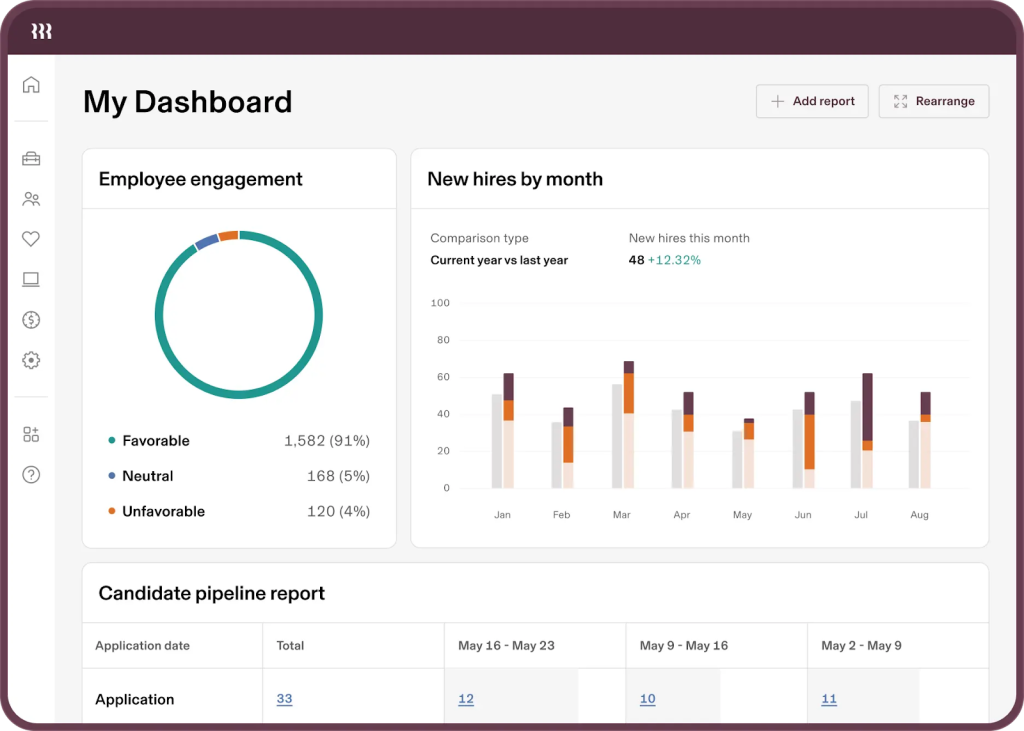
Image source: Rippling
On our first new hire after implementing Rippling, the IT lead looked at me in disbelief and said, “Wait, that’s it? We’re done?” Rippling automated everything: we could provision a new hire’s laptop, create their accounts, enroll them in benefits, and add them to payroll in one five-minute process.
What impressed me was Rippling’s modular nature – we started with the HR & IT basics, then later added more modules like time tracking and an applicant tracking system, only paying for what we needed. For that company, Rippling was a force multiplier that freed up hours of work and ensured nothing fell through the cracks during onboarding.
If you’re scaling fast or just want to eliminate the tedious admin across HR and IT, Rippling is a lifesaver.
Pros:
- All-in-one platform spanning HR, IT, and more – you can manage HR data, payroll, benefits, device management, app provisioning, and even finance integrations in one system.
- Powerful automation allows conditional workflows (e.g. “If new hire’s department is Sales, assign these specific onboarding steps”) that saves a ton of manual effort.
- Global payroll and workforce support helps to handle international payroll and contractor payments, which PerformYardalone cannot do .
- Rippling has 500+ integrations (from Google Workspace to Slack to Salesforce), making it easy to connect with your other business software.
How Gusto Compares to PerformYard:
Rippling stands out as an all-in-one HR platform that combines performance management with payroll, benefits, and IT management, making it great for companies seeking centralized operations. PerformYard, however, is more specialized, focusing exclusively on structured performance reviews, goal alignment, and feedback workflows. While Rippling offers convenience by integrating multiple HR functions, PerformYard provides deeper insights and customization for performance processes, making it the stronger choice for organizations prioritizing detailed employee evaluation and development.
Pricing:
Custom pricing.
6. Gusto – Easy Payroll & HR for Small Businesses
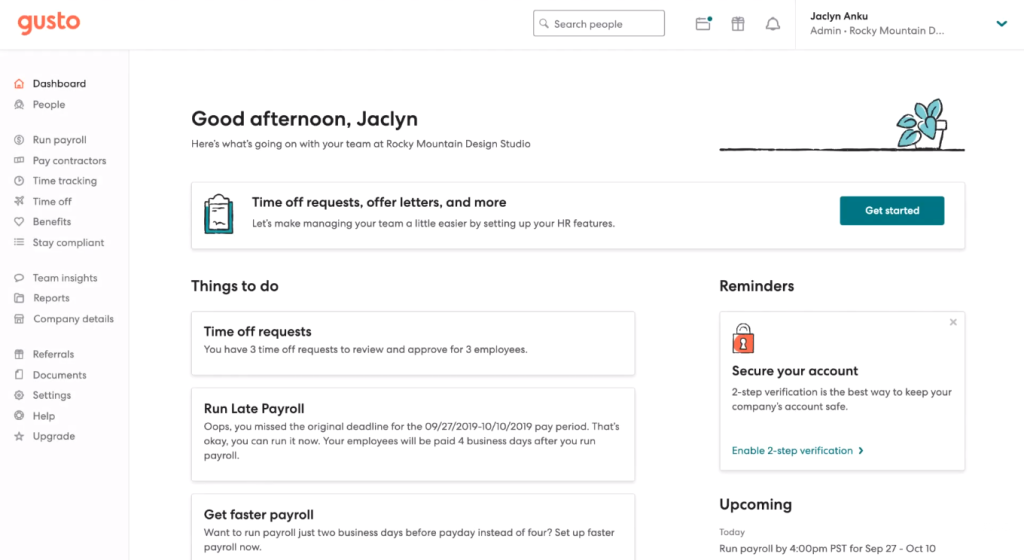
Image source: CompareCamp
A few years back, I worked with a family-owned bakery chain that had five locations and was struggling with payroll taxes across multiple states. They were actually using Gusto, but not leveraging half of its features. Gusto automatically filed their state and federal taxes, new hires were onboarded with all their paperwork done online, and even 401(k) contributions were handled easily.
It’s made for small business owners who don’t have a dedicated HR or payroll expert. The interface is friendly and the system covers all the important bases – from full-service payroll and tax filings, to basic HR onboarding, PTO tracking, and even benefits enrollment.
It’s not the most expansive HR tool on the market, but for payroll-focused needs it’s incredibly effective and stress-free.
Pros:
- Gusto calculates wages, deducts taxes, and files payroll taxes for all 50 states automatically, which removes a huge compliance burden .
- Employees can enroll in health insurance, 401(k), and other benefits through Gusto’s portal, and Gusto manages the deductions and even acts as your broker for plans.
- The interface is very intuitive, with step-by-step guides and to-do checklists (ideal if you don’t have an HR background).
- Beyond payroll, it handles onboarding forms (like W-4, I-9), PTO/time-off tracking, org charts, and has basic HR docs management.
How Gusto Compares to PerformYard:
Gusto is primarily known for its payroll and HR management features, with added tools for employee engagement and basic performance feedback. It’s a great option for small to mid-sized businesses that want to manage HR and performance in one place without much complexity. PerformYard, on the other hand, offers more robust capabilities for structured reviews, goal tracking, and performance analytics. While Gusto simplifies HR operations, PerformYard provides the depth and flexibility needed for organizations focused on continuous performance improvement and detailed employee development.
Pricing:
Starts at $49/month (base) + $6/user/month for the basic plan.
7. Zenefits (TriNet Zenefits) – Best for Administration & Compliance Support for SMBs

Image source: PCMag
I needed a way to centralize and simplify employee benefits management and overall HR processes. I tried using Zenefits, and within a month, the open enrollment went from a painful scramble to a smooth, mostly self-service process. Zenefits is great at bringing all the pieces together for small and mid-sized companies. Employees could compare health plan options and enroll themselves online, and Zenefits would automatically sync the deductions with payroll.
What I really like is that Zenefits doesn’t just digitize one piece of HR. It connects the dots between onboarding, payroll, benefits, and compliance so you’re not entering the same info in five places. For example, when we hired new employees, Zenefits would have them e-sign their offer letter and onboarding docs, walk them through benefit selections, and add everything into payroll without any extra data entry from HR.
It’s built for the real-world chaos of SMB HR. Limited time, lots of regulations to comply with, and employees who just want an easy way to get their paperwork done.
Pros:
- Comprehensive HR suite that covers core HR management (employee directory, time off, org charts), payroll, and especially strong benefits administration in one platform.
- Employees can log in to enroll in or change their benefits during open enrollment, update their info, and onboard themselves by e-signing documents, reducing HR’s workload.
- Built-in compliance tools that helps with ACA tracking (full-time equivalent calculations, 1095-C forms), sends alerts for compliance deadlines, and handles things like new-hire state reporting automatically.
- Integration of data like changes in one area (like an employee choosing a new health plan) automatically reflect in other areas (payroll deductions update, compliance tracked), so you don’t have to manually reconcile data.
How Zenefits Compares to PerformYard:
Zenefits is an HR platform that streamlines payroll, benefits, and onboarding, with some light performance management features included. It’s well-suited for smaller businesses looking for an all-in-one HR solution. PerformYard, in contrast, focuses specifically on performance management, offering more advanced tools for reviews, feedback, and goal alignment. While Zenefits simplifies day-to-day HR administration, PerformYard provides the structure and depth needed to drive employee performance and accountability across teams.
Pricing:
Starts at $8/user/month (for the Essentials plan; additional modules like payroll or advanced advisory services cost extra).
8. HiBob (Bob) – Best for Modern HRIS With Customizable Global Workflows

Image source: HiBob
HiBob (Bob) is an HRIS I’ve used that blends core HR management with light performance features. It simplified day-to-day HR tasks like onboarding, time-off tracking, and employee record management while adding tools for performance reviews, goal setting, and recognition. I found the interface clean and easy to navigate — creating review templates or surveys was simple thanks to its drag-and-drop builder.
What really stood out to me was the social element. The shoutouts and Kudos features encouraged peer recognition and made the company feed feel lively and positive. Since HiBob stores all employee data, everything from reviews to updates stayed connected without manual imports.
That said, its performance tools lean toward the basics. It’s well-suited for companies that want simple annual reviews or goal tracking, but teams looking for deeper analytics or ongoing performance monitoring might find it a bit limited.
Pros:
- Great for global HR – supports country-specific rules (local holidays, time-off policies, labor law compliance) so each office location can operate correctly while all being in one system.
- Includes rich personal details (hobbies, languages, etc.) and a social newsfeed where employees can recognize each other and share milestones, helping build a strong culture digitally .
- Customizable onboarding and workflows to help create different onboarding flows or HR processes per department/region, automating steps like sending region-specific documents or welcome emails to new hires.
- Offers pulse surveys, feedback polls, and people analytics that let you track engagement, turnover trends, and even DEI metrics across your workforce.
How HiBob Compares to PerformYard:
HiBob combines HR management and employee engagement in a modern, user-friendly platform, making it ideal for fast-growing companies that value culture and collaboration. It includes tools for feedback, surveys, and recognition but takes a more holistic approach to people management. PerformYard, meanwhile, is purpose-built for structured performance management, offering customizable review cycles, goal tracking, and performance analytics. While HiBob focuses on overall employee experience and HR operations, PerformYard delivers deeper functionality for managing and improving individual and team performance.
Pricing:
Starts at approximately $5/user/month (pricing is custom-tailored based on company size and modules).
9. ADP Workforce Now – Best for Enterprise-Grade HR & Payroll Suite

Image source: CompareCamp
ADP is not flashy, but it is rock-solid and reliable. ADP provided us with all the compliance tools imaginable – we could generate OSHA logs, EEO-1 reports, ACA compliance reports, you name it. The system allowed very granular permission controls (we had to give different HR reps access to only their region’s data, which ADP handled easily).
ADP Workforce Now truly shines when you have complexity – multiple locations, complex pay policies, strict compliance requirements – and you need a system that just handles it. I’ll be honest: it’s not the most modern-looking interface, and it takes a dedicated team to implement all the moving parts.
But if you need an HR platform that can scale to thousands of employees and never break a sweat on compliance or payroll accuracy, ADP is a proven choice. It let our HR team get ahead of the chaos and sleep better at night, knowing the basics were under control.
Pros:
- Comprehensive HR suite covers HRIS, payroll, time and attendance, benefits administration, talent management, and more in one platform, designed to handle large employee volumes.
- Includes built-in compliance reports for things like OSHA, EEO-1, ACA, and tools to manage complex regulations (multi-state tax, labor law changes) automatically.
- Can accommodate complex org structures with multiple divisions, custom approval workflows, and granular security roles/permissions for different users.
- ADP can connect directly to benefit providers (for insurance, etc.), so enrollment changes flow through without manual entry.
How ADP Workforce Now Compares to PerformYard:
ADP Workforce Now is a comprehensive HR suite that covers payroll, benefits, time tracking, and talent management, making it a strong choice for large organizations needing a unified HR solution. PerformYard, on the other hand, is dedicated specifically to performance management. It offers customizable review workflows, goal alignment, and continuous feedback tools that provide more depth and flexibility for managing employee performance. While ADP Workforce Now excels at automating HR operations, PerformYard stands out for its focus on detailed performance tracking and employee development.
Pricing:
Custom pricing.
10. Paylocity – Best for HR Activities With Built-in Engagement

Image source: B2B Reviews
One of the teams I worked with was stuck using spreadsheets for PTO tracking, an outdated payroll add-on, and a separate survey tool that nobody logged into. Introducing Paylocity to their environment was like a breath of fresh air. Paylocity delivered all the core HR and payroll functions we expected – recruiting, onboarding, time tracking, payroll, benefits, performance management – but it also brought something extra: built-in employee engagement tools.
Suddenly, the company had a social-media-like news feed where people could post kudos and shout-outs for their peers. Leadership could record short video announcements and share them with all staff through the portal. We ran anonymous pulse surveys and got real-time results on a dashboard that managers could actually act on.
For HR, a big win was not having to toggle between five different systems anymore. When someone asked, “How many PTO days has this person taken?” or “What’s our turnover rate this quarter?”, we could find it all in Paylocity without exporting data to Excel.
Pros:
- Covers the full employee life cycle (recruiting, onboarding, HR records, payroll, time tracking, benefits, performance reviews, etc.) suitable for small to mid-sized companies.
- Built-in engagement and communication with features like an internal social feed for recognition, the ability to share video announcements, and anonymous surveys with actionable reporting are integrated into the system.
- Offers customizable reports and dashboards (e.g., see time tracking data, payroll costs, turnover statistics) that help HR and managers make data-driven decisions without external tools.
- Paylocity is known to roll out updates frequently, adding features like scheduling or improved mobile functionality, often driven by client feedback from the mid-market segment.
How Paylocity Compares to PerformYard:
Paylocity offers a broad HR & payroll platform that spans everything from benefits and time-tracking to analytics and employee engagement. Against this, PerformYard is carved out for performance management—reviews, goals, feedback. If your focus is on evaluating and improving employee performance with detailed workflows, PerformYard gives deeper specialization. But if you want one system to manage payroll, HR operations and engagement (including performance), Paylocity brings all of that into one place.
Pricing:
Custom pricing.
My Top 3 Picks for PerformYard Alternatives
Here are three standout tools I recommend after personally testing and implementing them in different organizations:
1. PeopleGoal
PeopleGoal stands out for its flexibility and deep customization options. It lets you design your own performance and engagement workflows, automate check-ins, and integrate feedback loops with OKRs — all in one unified platform. I chose it because it empowers HR teams to build processes that truly reflect their culture instead of forcing them into predefined templates.
2. Lattice
Lattice impressed me with its ability to align goals from top to bottom, creating full transparency across teams. The continuous feedback system, 1:1 meeting templates, and engagement insights made performance discussions regular and impactful. I chose it because it helps companies shift from one-time reviews to a culture of ongoing growth and coaching.
3. 15Five
15Five stood out for how effectively it builds a culture of recognition and open communication. The weekly check-ins, “High Five” peer appreciation feature, and performance tracking tools make feedback part of everyday work. I chose it because it keeps employees motivated and connected, helping managers spot issues early and celebrate wins often.
Evaluation Criteria
When comparing alternatives to PerformYard, here are the key factors I focused on. Each of these elements can make or break your HR experience as your team scales and your processes mature.
- Flexibility of Reviews & Workflows
I’ve seen that every company has its own review rhythm — quarterly, biannual, or continuous. So, I prioritized platforms that let me design workflows around how people actually work, not how software dictates it. Being able to build 360° feedback cycles, department-specific reviews, and custom forms made the process feel tailored rather than forced. - Continuous Feedback & Engagement
I looked for tools that made feedback a daily habit instead of a yearly ritual. The best ones helped teams celebrate wins, share quick updates, and stay connected through pulse surveys and recognition feeds. For me, the real value was in creating a steady flow of conversation between managers and employees. - Goals/OKRs Alignment & Tracking
I wanted platforms that didn’t just let you set goals but actually tied them to the bigger company mission. The ability to align OKRs across departments and visualize progress in real time was a big plus. It made accountability clearer and gave everyone a sense of purpose behind their work. - Analytics, Insights & Reporting
Data is only useful if it leads to better decisions. So, I focused on platforms that turned performance and engagement data into actionable insights. Whether it was spotting top performers, identifying burnout risks, or improving review outcomes, I wanted tools that made HR strategy more data-informed and less guesswork. - Ease of Use & Adoption
If a tool feels complicated, no one uses it — it’s that simple. I paid close attention to how intuitive each platform was and how quickly teams could get onboarded. Clean interfaces, mobile accessibility, and a short learning curve made a huge difference in adoption rates. - Scalability & Cost-Effectiveness
Finally, I looked at whether the software could grow with the organization without breaking budgets. Flexible pricing, modular add-ons, and scalability were essential. I wanted tools that delivered long-term value, working just as well for a 20-person startup as they would for a 500-person enterprise.
Migrating from PerformYard: Best Practices and Pitfalls
Migrating to a new HR platform can feel daunting, but it doesn’t have to be stressful if you plan it out right. Here’s what I’ve learned from helping teams transition smoothly away from PerformYard.
1. Set up Your Migration Plan Early
Start with a clear roadmap. Audit all your existing data, from review cycles and goal records to employee feedback history. Identify what should move and what can be left behind. Assign clear ownership for each phase of the migration so that nothing slips through the cracks during the transition.
2. Communicate Clearly With Managers & Employees
Your people are the heart of this change. Let everyone know what’s coming, why the switch is happening, and how the new platform will make their work easier. The more transparent you are, the faster your teams will adopt the new system. Early involvement also helps you uncover potential roadblocks before go-live day.
3. Test Integrations Before Full Rollout
If your new platform connects with HRIS, payroll, or communication tools like Slack and Teams, make sure those integrations are tested thoroughly. It’s much easier to fix connection or data sync issues before the whole company is onboarded than after. A smooth tech ecosystem makes the new tool instantly more valuable.

4. Build Training & Support Resources
Even the most user-friendly platform needs a bit of guidance at first. Create step-by-step guides, sample workflows, or short training sessions tailored to different roles. The goal is to make employees feel confident, not confused. Hands-on sessions and open Q&A hours can go a long way in driving comfort and adoption.
5. Watch for Feature Creep & Cost Traps
As tempting as it is to activate every shiny new module, start small. Focus on core performance features first and add extras like engagement or learning tools once you’ve mastered the basics. This helps you control costs and ensures your team isn’t overwhelmed with too many new processes at once.
6. Don’t Neglect Data Cleanup
Clean data is the backbone of a successful migration. Remove duplicates, outdated employee profiles, or irrelevant review records before you transfer anything. A tidy database will make reports more accurate and your new system faster and easier to navigate from day one.
7. Monitor Adoption & Gather Feedback
Once you’re live, track how your team is using the new system — login frequency, review completion rates, or survey participation. Encourage honest feedback through quick polls or check-ins to see what’s working and what isn’t. If engagement dips, step in early with extra support or refresher sessions.
Streamline Performance Management with the Best PerformYard Alternatives
As you evaluate alternatives to the platform you currently use, it’s worth remembering what you’re ultimately striving for: a system that helps your people thrive, supports managers in real time, and reduces administrative drag so your HR team can focus on what matters most.
When your performance and engagement tools feel intuitive, flexible and aligned with how your business actually works, you’ll spend less time managing workflows and more time driving results. That means clearer goals, stronger feedback cultures and faster development of your talent.
And if you’re looking for a platform that lets you configure workflows, automate check-ins and tie engagement data into meaningful development plans, you may want to consider giving PeopleGoal a look—while keeping your selection based on what fits your team today and your growth tomorrow.
Frequently Asked Questions
Do alternatives to PerformYard support integrations with other HR and business systems?
Many modern alternatives emphasise integrations with HRIS, payroll, collaboration tools like Slack or Microsoft Teams, and learning management systems. Strong connectivity ensures the platform works within your existing tech stack rather than isolating performance management.
How do I choose the right PerformYard alternative for my company size and growth stage?
Start by assessing current pain points and where your business is headed: small teams may need quick setup and simplicity, while scaling or global organisations look for advanced analytics, multi-region support and integrations. Match features, budget and adoption readiness to the right growth stage.
How long does it typically take to implement a PerformYard alternative?
It depends on your size, data cleanup needs, and how customized your workflows are. For small to mid-sized organisations, a basic rollout (reviews, goals, feedback) can take a few weeks. If you migrate large datasets, integrate many systems, or configure complex workflows, the process can span a couple of months. Planning and early testing smooth the path to adoption.
Ready to 3x Your Teams' Performance?
Use the best performance management software to align goals, track progress, and boost employee engagement.



